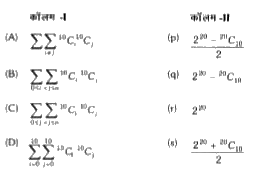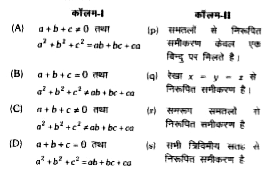माना कि धनात्मक पूर्णांक इस प्रकार है कि तब
का मान ( जब ) है
The correct Answer is:A, D
Step by step video, text & image solution for माना कि धनात्मक पूर्णांक इस प्रकार है कि (1+x)^(n)=C_(0)+C_(1)x+C_(2)x^(2)+...+C_(n)x_(n) तब sum_(r=0)^(s)sum_(s=1)^(n).^(n)C_(s)*.^(s)C_(r) का मान ( जब rles ) है by Maths experts to help you in doubts & scoring excellent marks in Class 12 exams.
Updated on:21/07/2023Topper's Solved these Questions
- द्विपद प्रमेय तथा गणितीय आगमन Book:ERRORLESS HINDIChapter:द्विपद प्रमेय तथा गणितीय आगमन Exercise:JEE Advanced (Integer type questions)
Explore 17 Videos
- द्विपद प्रमेय तथा गणितीय आगमन Book:ERRORLESS HINDIChapter:द्विपद प्रमेय तथा गणितीय आगमन Exercise:JEE Advanced (Matrix Math type questions)
Explore 5 Videos
- द्विपद प्रमेय तथा गणितीय आगमन Book:ERRORLESS HINDIChapter:द्विपद प्रमेय तथा गणितीय आगमन Exercise:JEE Advanced (Reasoning type questions)
Explore 11 Videos
- त्रिविमीय निर्देशांक ज्यामिति Book:ERRORLESS HINDIChapter:त्रिविमीय निर्देशांक ज्यामिति Exercise:JEE ADVANCED (Matrix Match type questions)
Explore 4 Videos
- निश्चित समाकलन एवं वक्रों से घिरा क्षेत्रफल Book:ERRORLESS HINDIChapter:निश्चित समाकलन एवं वक्रों से घिरा क्षेत्रफल Exercise:JEE ADVANCED (Matrix Match type questions)
Explore 9 Videos
Similar Questions
यदि (x2+2)8 के प्रसार में मध्य पद 1120 है तब x के सम्भव वास्तविक मानों का योग है
View Solutionनिम्नलिखित कॉलम I को कॉलम II से मिलाये

View Solutionकथन-1 : n∑r=0(r+1).nCr=(n+2)2n−1
कथन-2 : n∑r=0(r+1).nCrxr=(1+x)n+nx(1+x)n−1
View Solutionमाना निम्न रैखिक समीकरण है ax+by+cz=0,bx+cy+oz=0,cx+ay+bz=0 कॉलम । में दी गयी स्थितियों/व्यंजकों का कॉलम ॥ में दिए गए वक्तव्यों से सुमेल करें

View Solutionकॉलम I में दिए गए समाकलनों का कॉलम II में दिए गए मानों से सुमेल करे
कॉलम Iकॉलम II(A)∫1−1dx1+x2(p)12log(23)(B)∫10dx√1−x2(q)2log(23)(C)∫32dx1−x2(r)π3(D)∫21dxx√x2−1(s)π2
View SolutionThe value of sum_(r=0)^(n)sum_(s=1)^(n)*^(n)C_(5)*^(s)C_(r) is
View SolutionIf C_(0),C_(1),C_(2),.........,C_(n) denote the binomial coefficients in the expansion of (1+1)^(n), then sum_(0<=r
View SolutionIf C0,C1,C2,…,Cn denote the binomial
coefficients in the expansion of (1+x)n, then n∑r=0n∑s=0(Cr+Cs)
View SolutionIf C0,C1,C2,…,Cn denote the binomial
coefficients in the expansion of (1+x)n , then n∑r=0n∑s=0CrCs=
View SolutionIf C0,C1,C2,…,Cn denote the binomial
coefficients in the expansion of (1+x)n , then n∑0≤rn∑<s≤nCrCs=.
View SolutionIf (1+x)n=n∑r=0Crxr,(1+C1C0)(1+C2C1)...(1+CnCn−1) is equal to
View SolutionIf (1+x)n=C0+C1x+C2x2+….+Cnxn, then n∑r=0n∑s=0(r+s)CrCs is equal to :
View Solutionयदि (1+x)n=n∑r=0Crxr,
(1+C1C0)(1+C2C1)...(1+CnCn−1) का मान है
View Solutionयदि (1+x)n=n∑r=0Crxr तो (1+C1C0)(1+C2C1)...(1+CnCn−1)=
View Solutionमाना कि धनात्मक पूर्णांक इस प्रकार है कि (1+x)n=C0+C1x+C2x2+...+Cnxn तब
n∑r=0n∑s=0(Cr+Cs) का मान है
View Solution
